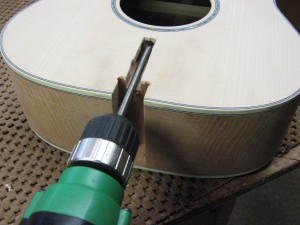Neck (Pt. 3)
Pegheads and fretboards are the two most common spots on a guitar where decorative inlays can be found. Adding some ornamentation in these areas can really dress up the guitar and, for my instruments, helps personalize it. I always encourage my customers to tell me what they would like to have in these places. Some customers don’t want anything at all, preferring the look of a simple, unadorned peghead and fretboard. Some customers want something, but they aren’t quite sure what, so they ask me for suggestions. For this guitar, my customer knew exactly what he wanted on the peghead and fretboard.
The peghead inlay is a “winged angel” which was cut by a man named David Nichols (www.custompearlinlay.com). He has been doing custom inlays for decades and has produced some amazing artwork. I have know him for quite a long time and his work is on many of my instruments. Here is a picture of the angel still attached to a piece of cardboard to keep the pieces in alignment.
It is made of several pieces of mother-of-pearl and abalone, with rosewood for the hair. All of the lines in the gown, wings and facial features are actually very fine saw cuts. Incredible! This sort of work is way beyond what I can do, which is why I am happy to know David Nichols.
Here I have covered the peghead with white poster paint and scribed the outline of the artwork. There isn’t much room on the peghead for this inlay, but it does fit between the string slots.
Next, I carefully rout away the wood where the angel will go using a very small router and proceding very slowly. Here is the peghead with the routing completed and the angel ready to be epoxied in.
After the glue dries everything is sanded smooth. Here is the inlaid angel along with a test fitting of the tuning machines.
Now the neck can be glued to the body. I first need to make room for the truss rod, which will be adjustable through the sound hole. It is certainly easier for me to have the truss rod adjusted at the peghead end, but there isn’t enough room on this particular peghead. This picture shows how the truss rod extends beyond the heel-end of the neck. It extends just far enought that the nut can be adjusted through the hole, but not so far that it will be plainly visible in the completed instrument.
Now I rout away the soundboard and drill a very carefully placed hole through the “upper face brace” where the adjusting nut will be located. This brace was intentionally made a little taller to compensate for the small loss of strength the drilling a hole might introduce. The gap in the soundboard will be hidden by the fretboard.
After checking the alignment of the neck to the body and making sure the truss rod fits in the neck slot several more times, the neck is glued to the body with yellow glue.
After this dries I can insert the pins into the neck that will lock everything in place for good. The pins are actually two short pieces of 5/16″ dowel rod. I drill two holes centered right in the middle of the neck tennon and the body mortice, one on each side of the truss rod channel.
The holes go down to within about 1/4″ of the back of the guitar. The hardwood dowels are inserted into the holes with some yellow glue and once this dries, I don’t have to worry about the neck separating from the body, regardless of the amount of tension put on that joint. I have been assembling guitars this way for over thirty years and, to my knowledge, no neck has ever pulled loose, so I am very comfortable with this approach. Here are the dowels ready to be glued in:
Now the truss rod is glued in with epoxy.










